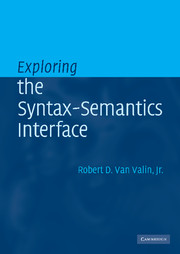Book contents
- Frontmatter
- Contents
- List of figures
- List of tables
- Preface
- List of abbreviations
- Introduction
- 1 Syntactic structure
- 2 Lexical representation and semantic roles
- 3 Information structure
- 4 Syntactic relations and case marking
- 5 Linking syntactic and semantic representations in simple sentences
- 6 The structure of complex sentences
- 7 Linking syntax and semantics in complex sentences
- References
- Languages index
- Subject index
7 - Linking syntax and semantics in complex sentences
Published online by Cambridge University Press: 18 December 2009
- Frontmatter
- Contents
- List of figures
- List of tables
- Preface
- List of abbreviations
- Introduction
- 1 Syntactic structure
- 2 Lexical representation and semantic roles
- 3 Information structure
- 4 Syntactic relations and case marking
- 5 Linking syntactic and semantic representations in simple sentences
- 6 The structure of complex sentences
- 7 Linking syntax and semantics in complex sentences
- References
- Languages index
- Subject index
Summary
General considerations
In this chapter the linking between semantic representations and syntactic representations in complex sentences is explored. An important question to be investigated is the extent to which the linking algorithms proposed in chapter 5 for simple sentences must be modified to deal with complex sentences. Most complex sentences pose no particular difficulties for the linking system developed in chapter 5. Clausal junctures, for example, are composed of clauses, each of which links like an independent clause. Moreover, nuclear junctures act for linking purposes like simple clauses containing a complex predicate, and they basically follow the algorithms for simple sentences. The real challenge comes from non-subordinate core junctures with their obligatory sharing of a core argument, as discussed in section 6.2. Accordingly, linking in clausal and nuclear junctures will be examined first. After the discussion of linking in the different juncture–nexus types and in complex NPs, reflexivization in complex constructions will be investigated, and again the question arises as to the extent to which the principles proposed in section 5.3 will have to be modified to deal with these new phenomena. In the final section an account of the restrictions on so-called ‘long-distance dependencies’ involved in WH-question formation, topicalization and relativization will be proposed. These restrictions, which fall under the principle known as ‘subjacency’ in the generative literature, are significant for linguistic theory, for theories of language acquisition and for related theories of cognitive organization.
- Type
- Chapter
- Information
- Exploring the Syntax-Semantics Interface , pp. 225 - 293Publisher: Cambridge University PressPrint publication year: 2005

